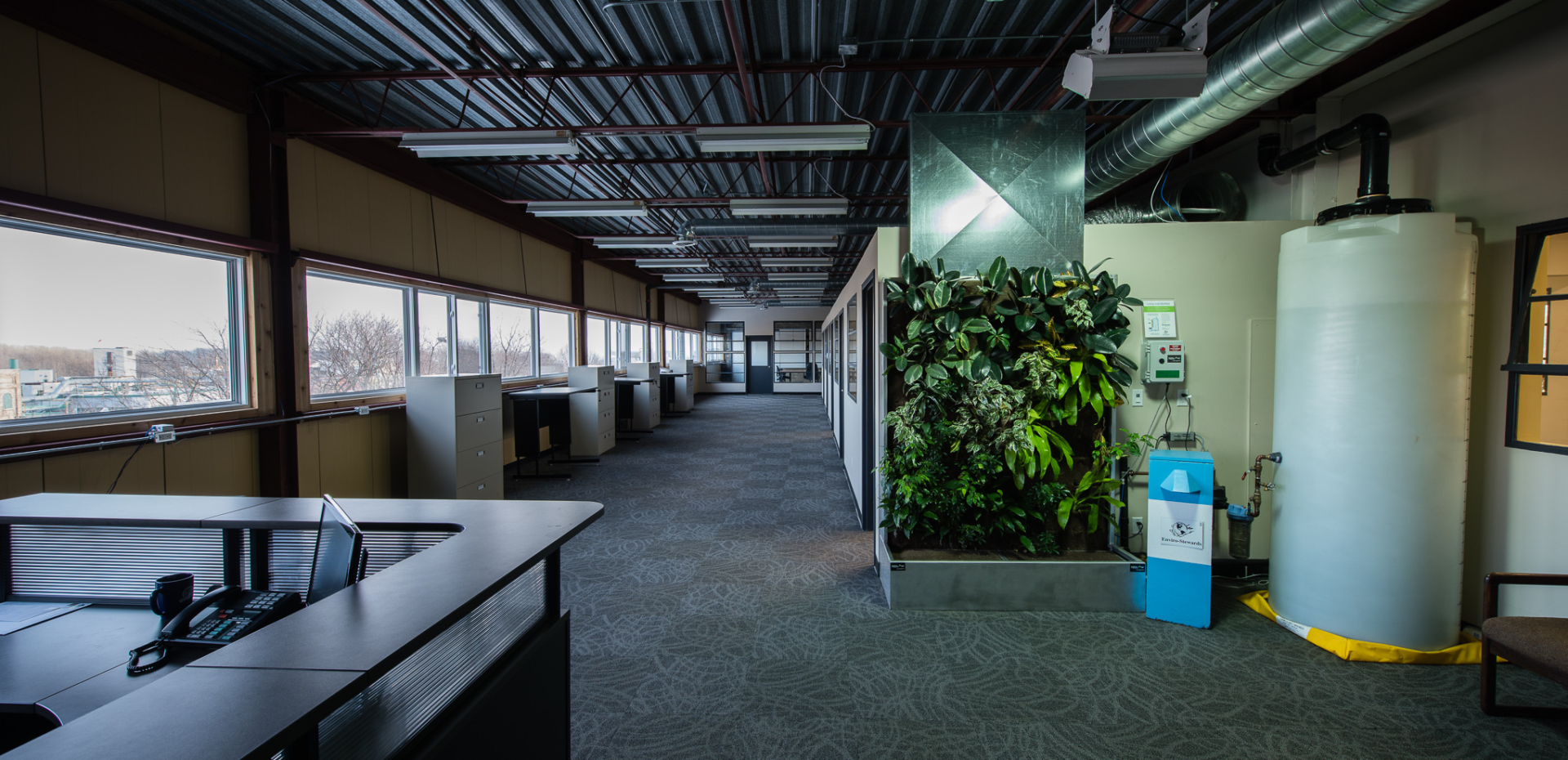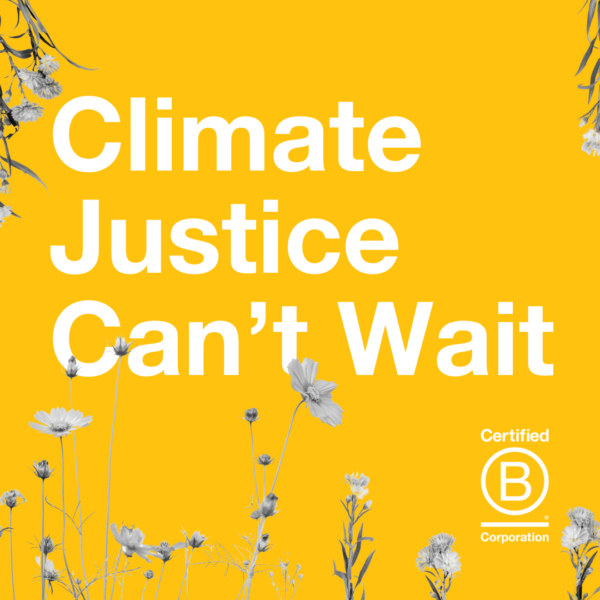B Corps Take Steps Toward Net Zero with New Climate Action Impact Topic
April 28, 2025
The Climate Action Impact Topic in the new standards for B Corp Certification is designed to help companies reduce their greenhouse gas emissions through measurement, goal-setting, and action. Learn how B Corps Enviro-Stewards and Room & Board are reducing emissions by seeking clean energy sources, including smart roofs and solar arrays, and identifying ways to reduce energy use.
As effects of the climate crisis accelerate, bringing more extreme weather events and higher sea levels, so does the need for action. The Intergovernmental Panel on Climate Change projects that global warming will prompt a 2-degree Celsius increase this century unless greenhouse gas (GHG) emissions are deeply reduced.
The new standards for B Corp Certification require businesses to take meaningful action across social, environmental, and governance Impact Topic areas. The Climate Action Impact Topic in the new standards emphasizes the important role that businesses play in reducing GHG emissions and limiting global warming. This Impact Topic requires companies to:
- Measure their emissions.
- Set targets to reduce their emissions.
- Implement climate transition plans and contribute to the global goal of net zero emissions by 2050.
About the 3 Scopes
Measuring and managing greenhouse gas (GHG) emissions is a critical part of business climate action.
Scope 1 are direct GHG emissions from the business. For example, if a business burns gasoline or natural gas, these combustion processes emit CO2.
Scope 2 emissions are indirect, meaning they are produced off-site from energy used on-site. Electricity is the most common form of Scope 2 emissions.
Scope 3 emissions are those from all other parts of a business supply chain. Learn more here.
B Corps that have already taken these steps and made progress include Enviro-Stewards, an engineering consulting firm with 18 workers based in Elmira, Ontario, and Room & Board, a 100% employee-owned furniture and decor retailer with 1,050 workers at its headquarters in Minneapolis, Minnesota, and stores and delivery centers across the United States.
The examples they share below help illustrate some aspects of the new Climate Action Impact Topic requirements. However, note that the B Corp Certification requirements are unique for each company based on size, location, and other factors.
Find your company’s tailored requirements on the B Impact platform.

A Guide to Climate Action in Practice
This guide from B Lab U.S. & Canada provides examples and resources from B Corps and partners to support companies in meeting requirements in the new Climate Action Impact Topic.
Climate Action 1: Measure greenhouse gas emissions.
What the standards say: The company has a documented process to measure its scope 1, 2, and 3 GHG emissions annually and discloses the results publicly. The company gets an independent third party to verify its annual GHG emissions inventory.
Find technical guidance starting on page 22 of the Climate Action Impact Topic B Lab resource.
What this looks like at Enviro-Stewards:
As an environmental engineering consulting company, Enviro-Stewards helps customers profitably achieve their sustainability goals — whether that’s net zero, carbon neutral, climate positive, or utility use reduction — by identifying practical and affordable measures to reduce consumption at the process level. On an internal level, the B Corp measures its scope 1 and scope 2 based on utility use. Although Enviro-Stewards leases office space in a multi-tenant building, its office has separate gas, water, and electricity meters. Staff members use these readings to calculate the associated GHG emissions. The Enviro-Stewards office also features a living wall covered with plants (shown in photo at top of this article).
Bruce Taylor, President of Enviro-Stewards, said the B Corp also has installed clamp-on meters to measure electricity, natural gas, and water use on a per-minute basis. With those measurements, Enviro-Stewards can analyze energy and water use to identify ways it may be reduced or eliminated.
“For example, Enviro-Stewards logs the CO2 removed by its living wall and only takes outside air when required. This has reduced our air intake by 97%,” he said. “We’ve also adjusted the temperature setpoints so that the heat pump can provide the bulk of the heating demand, and the main HVAC system only needs to provide heat when the heat pump cannot reach the setpoint temperature. Because the heat pump uses electricity instead of natural gas, like the HVAC does for energy, there are GHG emission reductions.”
What this looks like at Room & Board:
To annually measure its GHG emissions, Room & Board collects data from a variety of sources and uses an Excel-based tool to track the information. Emily McGarvey, Director of Sustainability, said the B Corp gets data for its natural gas (scope 1) and electricity (scope 2) from a third-party bill payer for the utility companies. Fuel use for its fleet of delivery trucks is a scope 1 measurement calculated through field purchases and gallons pumped.
Scope 3 measurements are a work in progress at Room & Board, McGarvey said. “We currently are limited in what we measure and manage for scope 3, but do include third-party logistics and employee travel. We will continue to increase scope 3 measurements over time.”
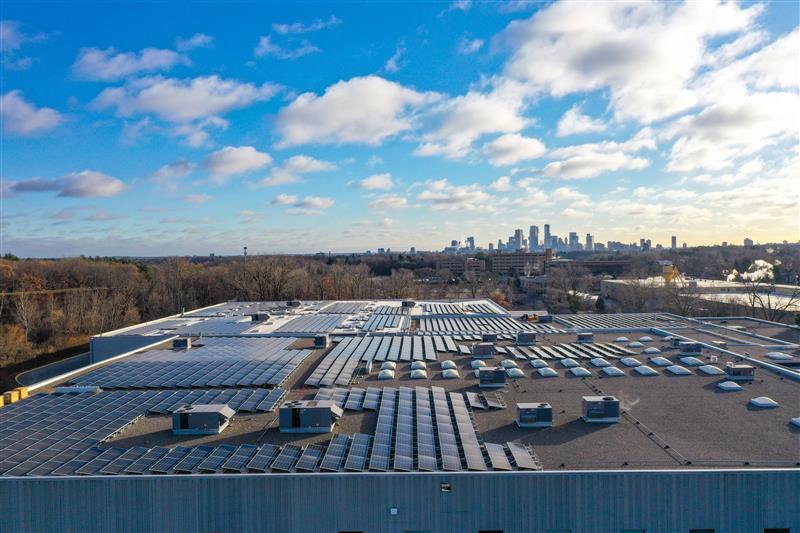
Room & Board installed a solar array in 2024 at its Minneapolis headquarters as a source of clean energy.
Climate Action 2: Set targets to reduce emissions.
What the standards say: Companies will set a net-zero target with interim goals to reduce GHG emissions. These interim goals will be updated every five years to achieve net-zero emissions by 2050.
Find technical guidance starting on page 38 of the Climate Action Impact Topic B Lab resource.
What this looks like at Enviro-Stewards:
Enviro-Stewards committed to an 80% reduction target for its scope 1 and scope 2 emissions per employee as part of Sustainable Waterloo Region (SWR), a social enterprise nonprofit formed to help local businesses and the region become environmentally and economically sustainable and resilient. Through SWR, Enviro-Stewards verifies and publicly reports its emissions data.
Specific elements of Enviro-Stewards’ goals as part of SWR are to:
- Reduce GHG emissions associated with daily operations to remain climate-positive while assisting clients to achieve this benchmark; avoid 500 tons of GHG emissions (for clients) for every ton of GHG generated by their operations.
- Help facilities reduce losses throughout their supply chains by aiding them in avoiding at least 20,000 tons of GHG emissions per year.
- Help shift public opinion to focus on waste prevention and greater efficiency rather than waste management and renewables.
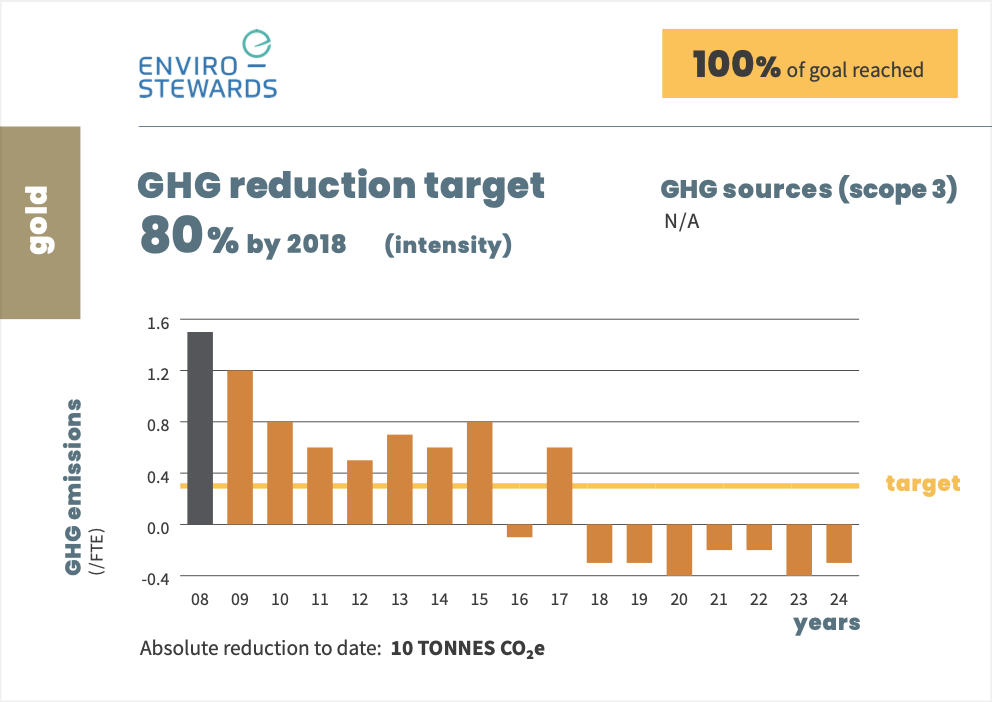
The chart provided by Sustainable Waterloo Region plots Enviro-Stewards’ GHG emissions per full-time employee from 2008 to the end of 2024. As shown in the chart, the company has been climate positive since 2018.
The whole Enviro-Stewards team gets an opportunity to shape the company’s GHG initiatives during discussions at regular staff meetings. Taylor said the company also created a Green Team to oversee office climate initiatives that take aim at emissions and track organic, recycling, and solid waste output. “They organize an annual bike challenge where employees track their kilometers in a spreadsheet when they bike to work,” he said. “The spreadsheet calculates the resulting GHG emissions savings based on the entered kilometers, so each employee can see their individual and group environmental impact of choosing to commute by bike instead of by car to the office.”
What this looks like at Room & Board:
To better measure the company’s progress on reducing emissions, Room & Board’s sustainability team partnered with its board of directors to set a public-facing goal: achieving a 50% reduction of scope 1 and 2 GHG emissions compared to its 2019 baseline. In 2024, Room & Board reached 27% of its 2019 baseline, McGarvey said. “We also have a public-facing goal to reach 100% renewable electricity use in our operations by 2030,” she said.
In 2022, the facility and sustainability teams at Room & Board searched for options to shift to more renewable electricity. A few of its retail locations had been able to procure clean energy from their local utilities, so Room & Board identified and joined other clean energy programs where available across the country. “We were able to increase our renewable electricity from 20% to 65%,” McGarvey said. “It was an impactful shift that was surprisingly economical.”
The clean energy initiative falls under Room & Board’s “better for the planet” impact focus, which also includes circularity and waste and clean transportation.

Driving Climate Action Through Your Business Finances
This guide provides resources and guidance to help companies align their financial choices with their organizational values. Get insights and concrete steps to select a financial institution that will help your business advance climate justice.
Climate Action 3: Implement a climate action plan and demonstrate progress.
What the standards say: Companies will develop a climate transition plan to achieve net zero goals. At recertification, companies must show progress through their climate transition plan.
Find technical guidance starting on page 72 of the Climate Action Impact Topic B Lab resource.
What this looks like at Enviro-Stewards:
The three goals that Enviro-Stewards set as part of its SWR partnership serve as its climate action plan. The B Corp also maintains a spreadsheet that totals the environmental impacts of its services, including water conservation and emissions reduction.
One change that made a visible and measurable impact for Enviro-Stewards was the May 2022 installation of a smart blue roof on its office. The roof collects and retains rainwater, which reduces stormwater discharge and avoids overloading the century-old piping. A portion of the collected rainwater also drains into a storage tank inside the office, which is used to irrigate the office living wall and to flush toilets, offsetting potable water consumption.
Taylor said energy savings is one surprising benefit of the roof. “During the summer, the water on the roof evaporates, which cools the building and reduces the load on the HVAC system,” he said. “The decreased energy consumption results in GHG emissions reductions associated with the electricity savings.”
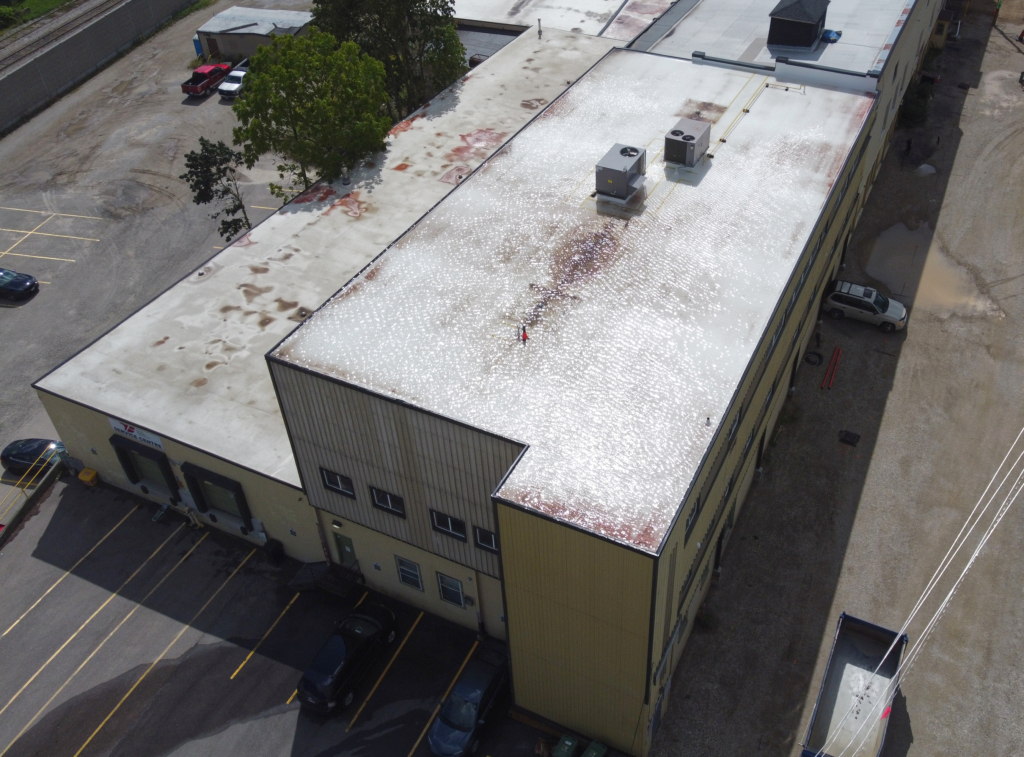
A smart blue roof at Enviro-Stewards collects and retains rainwater, which is used in part to offset potable water consumption.
Because the new roof is also more insulating, it helps the building retain more heat during winter. That reduces the need for natural gas combustion used to heat the building. Enviro-Stewards calculates that the roof has reduced its use of air conditioning by 43%, heating by 50%, and water consumption by 56%.
Taylor said it’s rewarding to share the company’s environmental progress with the Enviro-Stewards team. “The most exciting development has been the ability to measure and quantify the tangible results of our initiatives and communicate these findings to our staff,” he said. “This helps motivate staff to maintain their efforts and identify additional strategies to further reduce our GHG emissions.”
What this looks like at Room & Board:
Several teams across the company are working to create a climate action plan for Room & Board. McGarvey said the B Corp also joined the U.S. Department of Energy’s Better Climate Challenge to gain insight into more advanced solutions.
One recent addition at Room & Board’s Minneapolis headquarters is a big step toward reducing GHG emissions. A rooftop solar array installed in 2024 is designed to produce 120% of the site’s consumption.
McGarvey said the solar array project required partnership from teams across the organization, including finance, facilities, sustainability, and its leadership team, each of which brought unique expertise to the project. “The array is a visible reminder of our commitment to our GHG reduction efforts,” she said.
Future projects include a pilot of heat pumps in Room & Board’s cold-climate locations to help shift away from the use of natural gas for heating. “We are also working to electrify our delivery fleet,” McGarvey said. “Hybrid trucks have been a part of our fleet since 2017, and we are exploring options for fully electric delivery trucks.”
Identifying ways to reduce its climate footprint and making them a reality requires a company-wide effort, McGarvey said. “The sustainability team alone cannot achieve the needed impact. Being a B Corp solidifies our commitment and aspiration to be a sustainability leader that positively impacts people and the planet.”
Sign Up for our B The Change Newsletter
Read stories on the B Corp Movement and people using business as a force for good. The B The Change Newsletter is sent weekly.
